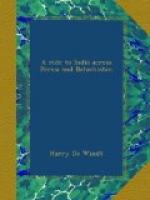Travelling in the daytime soon became impossible, on account of the heat, as we proceeded further inland. A start was therefore generally made before it was light, and by 11 a.m. the day’s work was over, tents pitched, camels turned loose, and a halt made till three or four the next morning. Though the sun at midday was, with the total absence of shade, dangerously powerful, and converted the interior of our canvas tents into the semblance of an oven, there was little to complain of as regards weather. The nights were deliciously cool, and the pleasantest part of, the twenty-four hours was perhaps that from 8 till 10 a.m., when, dinner over and camp-fires lit, the Baluchis enlivened the caravan with song and dance. Baluch music is, though wild and mournful, pleasing. Some of the escort had fine voices, and sang to the accompaniment of a low, soft pipe, their favourite instrument. Gerome was in great request on these occasions, and, under the influence of some fiery raki, of which he seemed to have an unlimited stock, would have trolled out “Matoushka Volga” and weird Cossack ditties till the stars were paling, if not suppressed. As it was, one got little enough rest, what with the heat and flies at midday, and, at the halt about 8 a.m., the shouting, hammering of tent-pegs, and braying of camels that went on till the sun was high in the heavens.
There is a so-called town or village, Jhow (situated about twenty miles east of Noundra), in a sparsely cultivated plain of the same name. Barley and wheat are grown by means of irrigation from the Jhow river, which in the wet season is of considerable size. I had expected to find, at Jhow, some semblance of a town or village, as the Wazir of Beila had told me that the place contained a population of four or five hundred, and it is plainly marked on all Government maps. But I had yet to learn that a Baluch “town,” or even village, of forty or fifty inhabitants often extends over a tract of country many miles in extent. The “town” of Jhow, for instance, is spread over a plain thirty-five miles long by fourteen broad, in little clusters of from two to six houses. A few tiny patches of green peeping out of the yellow sand and brushwood, a wreath of grey smoke rising lazily here and there at long intervals over the plain, a few camels and goats browsing in the dry, withered herbage by the caravan-track, showed that there were inhabitants; but we saw no dwellings, and only one native, a woman, who, at sight of Gerome, who gallantly rode forward to address her, turned and fled as if she had seen the evil one. Noundra, which was reached on the 30th of March, was a mere repetition of Jhow. Neither houses nor natives were visible, though we passed occasional patches of cultivated ground. About five miles west of this we left the beaten track and struck out due north for Gwarjak, which, according to my calculation, lay about seventy miles distant.
[Footnote A: The traveller Masson says that the word Brahui is a corruption of Ba-roh-i, meaning literally, “of the waste.”]




